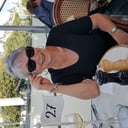Which fruit is depicted in the picture?
"Platonia insignis" is a dry-season deciduous tree, reaching 25–40 m high (65-131 ft). It has a pyramidal crown and copious yellow latex in the bark. The leaves are opposite, simple oblong to elliptic, 8–15 cm long (3-6 in), and glossy dark green, with wavy margins and a leathery texture.
It is native to South America in the humid forests of Brazil, Paraguay, parts of Colombia and northeast to Guyana; especially in Amazon Rainforest. Common names include bacuri, maniballi, naranjillo and bacurizeiro.
The flowers are 5–7 cm (1-2 in) long and pink in color, with five petals and numerous stamens. The fruit is round to oval and 7–14 cm long (2-5 in), with a thick, yellow skin. It resembles a papaya. The rind exudes a yellow latex when pressed. The sticky white pulp is fragrant, with a taste that is both sweet and sour. There are 3 to 5 seeds.
The bacuri is grown for its fruit, which is made into various condiments and beverages. It contains high levels of phosphorus, iron, and vitamin C. The oily brown seeds are used as a home remedy to treat skin conditions. Its yellowish wood is frequently used as timber.
The grease of the bacuri oil has a high absorption rate, due to its high level of tripalmitin (50% to 55%), which penetrates the skin quickly. The high amount of fatty palmitoleic acid (5%), compared to other oils (less than or equal to 0.5 to 1.5%), makes the bacuri oil useful as an emollient and moisturizing agent.
More Info:
en.wikipedia.org







